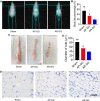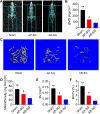The Effects of Antral Preservation and Antral Resection on Body Composition, Glycemic Control and Bone Mineral Density Following Vertical Sleeve Gastrectomy in C57BL/6J Mice with Obesity and Type 2 Diabetes
- PMID: 35140488
- PMCID: PMC8820379
- DOI: 10.2147/DMSO.S351973
The Effects of Antral Preservation and Antral Resection on Body Composition, Glycemic Control and Bone Mineral Density Following Vertical Sleeve Gastrectomy in C57BL/6J Mice with Obesity and Type 2 Diabetes
Abstract
Purpose: Sleeve gastrectomy (SG) is the most currently popular operation for obesity and related metabolic disorders. The aim of this study was to compare the effect of antrum preservation SG (AP-SG) and antrum resection SG (AR-SG) on the body composition, glycemic control and bone mineral density (BMD) in mice.
Methods: Sham, AP-SG and AR-SG operation were performed on obese and T2D C57BL/6J mice (8 in each group). Body weight, food intake, and fasting glucose (FG) levels were measured at the 0, 2, 4, 6 and 8 weeks post-operatively. Oral glucose tolerance test (OGTT) was performed preoperatively and at the eighth postoperative week. The body fat content and total body BMD were evaluated by dual-energy x-ray absorptiometry. After being euthanized, the femurs were harvested and analyzed by micro-CT.
Results: The improvements in body weight, food intake, FG, glycemic control and body fat were statistically significant following AP-SG and AR-SG. Both AP-SG and AR-SG groups decreased total body BMD and regional BMD in the distal femur compared to the sham group. No significant difference of FG was observed in AP-SG and AR-SG group postoperatively, but AR-SG showed significantly superior OGTT glucose AUC than AP-SG. Except for a lower BMD, AR-SG achieved superior outcomes in body fat and glycemic control than AP-SG.
Conclusion: Antrum resection SG shows a lower percentage of body fat and better glycemic control than antrum preservation SG. However, antrum resection SG has a higher risk of having a lower bone mass. Further human clinical trials are needed to confirm this finding.
Keywords: antrum preservation; antrum resection; body fat; bone mineral density; sleeve gastrectomy.
© 2022 Qi et al.
Conflict of interest statement
The authors report no conflicts of interest in this work.
Figures



Similar articles
-
Antrum Preservation Versus Antrum Resection in Laparoscopic Sleeve Gastrectomy With Effects on Gastric Emptying, Body Mass Index, and Type II Diabetes Remission in Diabetic Patients With Body Mass Index 30-40 kg/m2: a Randomized Controlled Study.Obes Surg. 2022 May;32(5):1412-1420. doi: 10.1007/s11695-022-05982-5. Epub 2022 Mar 19. Obes Surg. 2022. PMID: 35304705 Free PMC article. Clinical Trial.
-
Outcomes of laparoscopic sleeve gastrectomy with and without antrectomy in severely obese subjects. Evidence from randomized controlled trials.Surg Obes Relat Dis. 2022 Mar;18(3):404-412. doi: 10.1016/j.soard.2021.11.016. Epub 2021 Nov 20. Surg Obes Relat Dis. 2022. PMID: 34933811
-
Effects of sleeve gastrectomy on bone mass, microstructure of femurs and bone metabolism associated serum factors in obese rats.BMC Endocr Disord. 2021 Aug 26;21(1):173. doi: 10.1186/s12902-021-00843-1. BMC Endocr Disord. 2021. PMID: 34445970 Free PMC article.
-
Predictors of glycemic control after sleeve gastrectomy versus Roux-en-Y gastric bypass: A meta-analysis, meta-regression, and systematic review.Surg Obes Relat Dis. 2018 Dec;14(12):1822-1831. doi: 10.1016/j.soard.2018.08.027. Epub 2018 Sep 8. Surg Obes Relat Dis. 2018. PMID: 30385071
-
Changes in bone mineral density and bone metabolism after sleeve gastrectomy: a systematic review and meta-analysis.Surg Obes Relat Dis. 2019 Aug;15(8):1252-1260. doi: 10.1016/j.soard.2019.06.006. Epub 2019 Jun 18. Surg Obes Relat Dis. 2019. PMID: 31311755
Cited by
-
Bariatric Surgery Associates with Nonalcoholic Steatohepatitis/Hepatocellular Carcinoma Amelioration via SPP1 Suppression.Metabolites. 2022 Dec 21;13(1):11. doi: 10.3390/metabo13010011. Metabolites. 2022. PMID: 36676937 Free PMC article.
-
Multiomics analyses decipher intricate changes in the cellular and metabolic landscape of steatotic livers upon dietary restriction and sleeve gastrectomy.Int J Biol Sci. 2024 Aug 19;20(11):4438-4457. doi: 10.7150/ijbs.98362. eCollection 2024. Int J Biol Sci. 2024. PMID: 39247824 Free PMC article.
References
-
- Debédat J, Amouyal C, Aron-Wisnewsky J, et al. Impact of bariatric surgery on type 2 diabetes: contribution of inflammation and gut microbiome? Semin Immunopathol. 2019;41:461–475. - PubMed
LinkOut - more resources
Full Text Sources
Research Materials

